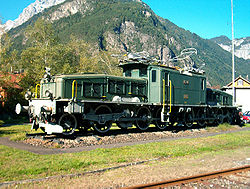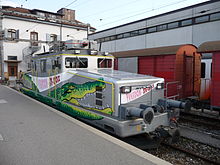- Crocodile (locomotive)
-
Crocodile electric locomotives are so called because they have long "noses" at each end, reminiscent of the snout of a crocodile (see also Steeplecab). These contain the motors and drive axles, and are connected by an articulated center section. The center section usually contains the crew compartments, pantographs and transformer.
The name was first applied to Swiss locomotives. Sometimes the term is applied to locomotives in other countries of a similar design.
Contents
History
The original "Crocodiles" were the series SBB Ce 6/8 II and SBB Ce 6/8 III locomotives of the SBB, Swiss Federal Railways, built between 1919 and 1927. These locomotives were developed for pulling heavy goods trains on the steep tracks of the Gotthardbahn from Lucerne to Chiasso, including the Gotthard Tunnel.
The electric motors available at the time were large and had to be body-mounted, but flexibility was required to negotiate the tight curves on the Alpine routes and tunnels. An articulated design, with two powered nose units bridged with a pivoting center section containing cabs and the heavy transformer, met both requirements and gave excellent visibility from driving cabs mounted safely away from any collision. These locomotives, sometimes called the 'Swiss Crocodile' or 'SBB Crocodile', were highly successful and served until the 1980s. Several are still in operation as preserved historical locomotives.
Very similar locomotives were used in Austria as Austrian Federal Railways (Österreichische Bundesbahn) classes ÖBB 1089 and ÖBB 1189, and are often known as 'Austrian Crocodiles'.
After the Swiss and Austrian standard gauge Crocodiles, the best known are the Rhaetian Railway (RhB)'s metre gauge locomotives of class Ge 6/6 I, the Rhaetian Crocodile. Several of these still run on passenger trains on special occasions. They are also used on freight trains in busy periods. The Bernina Railway (later merged with the RhB) also built a single Crocodile type, the Ge 4/4, nicknamed the 'Bernina Crocodile'. This locomotive survives and is being restored to operating condition.
Two Swiss narrow-gauge railways also have locomotive nicknamed Crocodiles; the BVZ Zermatt-Bahn (BVZ) (which merged with the Furka-Oberalp-Bahn (FO) in 2003 to form the Matterhorn-Gotthard-Bahn) uses series HGe 4/4 I, known as the Zermatt crocodile, while the Chemin de Fer Yverdon-Ste. Croix owns a solitary class Ge 4/4 #21. Neither of these locomotive types have an articulated body, which leads some railfans to nickname them "false crocodiles".
The German classes E 93 and E 94, also used by the ÖBB as series 1020, are sometimes called 'German crocodiles'. They are sometimes nicknamed "Alligators", instead, because of their broader, shorter snouts.
The French DC 25 kV CC locomotives of series 14000 and 14100 of the SNCF, used mainly for iron ore trains on the Thionville-Valencienne line, were also nicknamed "crocodile".
Crocodile locomotives were also used in India. These locomotives, of series WCG1, were used from 1928 between Bombay and Pune, and were all built to the Indian broad gauge of 5 ft 6 in. The first 10 locomotives were built by Swiss Locomotive and Machine Works. Vulcan Foundry of Great Britain constructed a further 31 examples for this line.
Other Crocodile-like locomotives
The articulated-body design was not unique to the Crocodiles. It was used in the United States on the Milwaukee Road class EP-2 "Bi-Polars", for example. Many more locomotives adopted the design of long noses without articulation of the body: see Steeplecab.
Video Game Appearances
- It appears in Chris Sawyer's Locomotion in the Alpine Scenario, introduced in 1920 and obsolete by 1965.
- It appears as one of the purchasable trains in Sid Meier's Railroads!, named the Ge 6/6 Crocodile. It was a mixed traffic engine capable of 64 km/h and available for $80,000.
External links
Rolling stock of Austria Locomotives DieselÖBB Class 2016 · ÖBB Class 2048 · ÖBB Class 2070ElectricÖBB Class 1016 (Taurus) · ÖBB Class 1018 · ÖBB Class 1043 · ÖBB Class 1089 (crocodile) · ÖBB Class 1116 (Taurus) · ÖBB Class 1189 (crocodile) · ÖBB Class 1216 (Taurus)High speed trains Multiple units DieselÖBB Class 5022 · ÖBB Class 5047ElectricÖBB Class 4011 · ÖBB Class 4020 · ÖBB Class 4023 (Talent) · ÖBB Class 4024 (Talent) · ÖBB Class 4030 · ÖBB Class 4124 (Talent)See also Category:Rolling stock of Austria, ÖBB rolling stock and Rail transport in Austria Categories:- Electric locomotives
Wikimedia Foundation. 2010.



